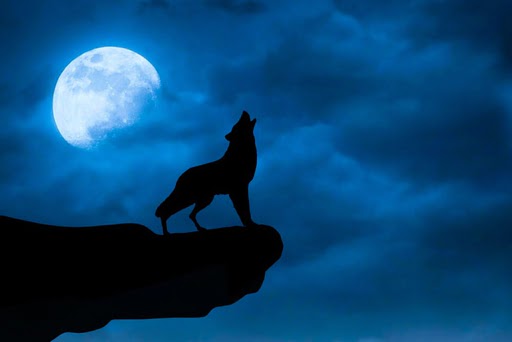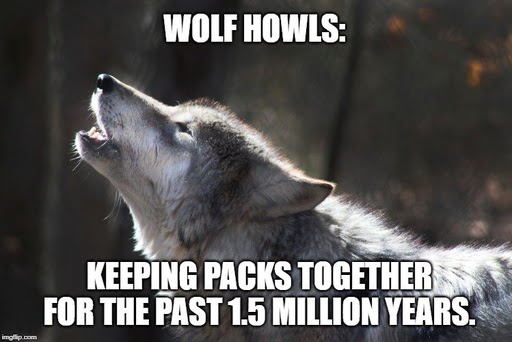Wolves howl at the moon as a means of long-distance communication to protect themselves and their pack, mark their territory, or attract potential mates.
If you’ve ever been camping in the wilderness and suddenly heard the silence broken by the howl of a wolf, then you understand the captivating and spine-chilling call of the wild. Since childhood, we have been told that wolves howl at the moon, and if you’ve ever seen a picture of a wolf with its snout turned towards the sky, illuminated by moonlight, that explanation seems logical.
 Howling wolf (Photo Credit: pxhere)
Howling wolf (Photo Credit: pxhere)
Are Wolves Calling To The Moon?
It may be a romantic idea, but the truth is that wolves are not howling at the moon; they have no more interest in our lunar companion than the rabbits they hunt and the fleas that live in their fur. Before we delve into the actual reason behind wolf howling, it is important to clear up this question.
Throughout human history, various cultures have created stories to explain things they don’t understand. Natural phenomena were often associated with these traditional stories and passed down through generations. In Greek, Roman, and Norse mythology, there was a strong connection between wolves and the moon, and Native American legends often portrayed wolves as the guardians of the moon, howling it into existence at night. Over time, these legends became traditional knowledge, despite lacking any real scientific basis, only being based on personal experiences.

Modern research studies have shown that wolves do not howl in any specific pattern related to the moon. In other words, whether it’s a full moon, a new moon, or any phase in between, even on a completely cloudy night or before the moon rises, wolves are still known to howl. There is no statistical significance to their frequency, duration, or intensity in relation to the presence of the moon.
So… why do they howl at all?
The Howls Of Wolves
Wolf howls may be some of the most dramatic and spine-chilling calls in nature, but they are similar to the calls of numerous other animals, from primates and owls to whale songs and the croaking of toads. Communication in animal species is just as important as it is in humans, whether it’s to warn others of danger, indicate the location of food, find a mate, or signal one’s location when lost. Human language may appear much more complex, but there is a remarkable amount of nuance in the calls of wild animals. Furthermore, when it comes to wolves, more research has been conducted on their distinct howls than almost any other species.
While the most common explanation for the “wolf calling the moon” phenomenon is their raised heads while howling, there is a simple explanation for that – it helps the sound travel farther. A full-throated wolf howl can sometimes be heard up to 6 miles in any direction, and if they are on flat, unobstructed terrain, their howl can travel up to 10 miles. This allows wolves to stay in contact with each other even when a pack is spread out.

Another reason why wolves howl at night is because they are nocturnal creatures. They are not active during the day, so they need to communicate efficiently at night. Wolves also bark, whimper, and growl, which are sounds that humans are more familiar with due to their close relationship with domesticated dogs. However, even pet dogs sometimes howl like wolves if they hear other dogs doing it in the neighborhood. Despite being trained and having cute names like Fido and Princess, dogs are still wild animals and have some of the instincts of their wolf ancestors!
Wolves need to communicate with each other about important matters such as danger, location, mating, and dominance. Howling helps wolves signal their location to the rest of the pack, which can be helpful if the pack has been separated. Howling also serves as a warning to other packs or lone wolves to stay away, as the territory is already claimed by an established pack. This leads to an interesting form of howling called “chorus howls,” where multiple wolves howl together, making it difficult to determine the pack’s size. This trick is used by packs to conceal their strength from rival packs, making them less likely to fight for territory or mates.
There are other reasons for wolf howls, which can be distinguished by the volume, pitch, and duration of the howls. Lower-pitched and frequent howls usually come from dominant males, while higher-pitched howls, resembling whimpers, indicate submission. These howls also establish the hierarchy for mating, with alpha males howling more intensely to attract potential mates.

Interestingly, howling can be a disadvantage for “lone wolves” who have lost their pack or been rejected. Without a pack to support them in times of need or during fights, howling can attract other predators or expose their location. So, while howling confirms a wolf’s place within a pack, it can have negative consequences for wolves without a group.
A Final Word
The next time you hear a wolf howl in the woods under a full moon, it is not the beginning of a werewolf horror movie, nor are the wolves communicating with celestial objects. They are simply using their voices to communicate over long distances to protect themselves and their pack, establish their territory, or attract potential mates to ensure the survival of the pack!
